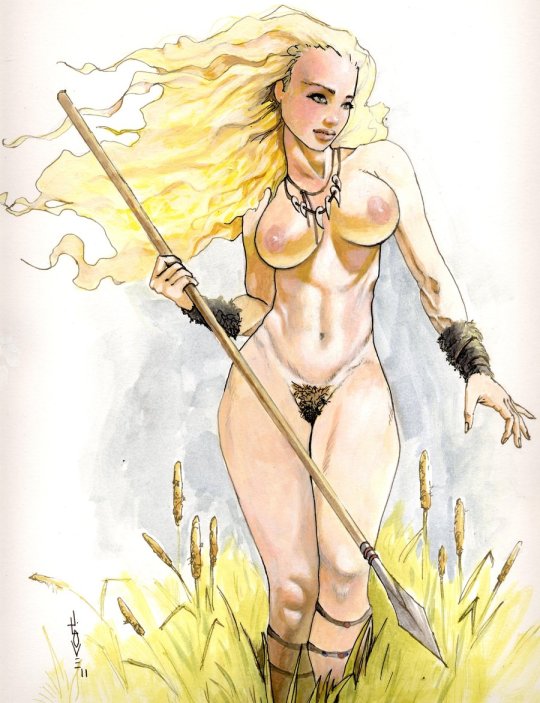#Women warriors
Text

“Bear Fang” by Tim Okamura
1K notes
·
View notes
Text
"Dr Sarah Stark, a human skeletal biologist at Historic England, said the findings provided “evidence of a leading role for a woman in warfare on iron age Scilly.”
“Although we can never know completely about the symbolism of objects found in graves, the combination of a sword and a mirror suggests this woman had high status within her community and may have played a commanding role in local warfare, organising or leading raids on rival groups.”
Stark added: “This could suggest that female involvement in raiding and other types of violence was more common in iron age society than we’ve previously thought, and it could have laid the foundations from which leaders like Boudicca would later emerge.”"
#warriors#history#women in history#warrior women#women warriors#women's history#iron age#archeology#england#english history
440 notes
·
View notes
Photo

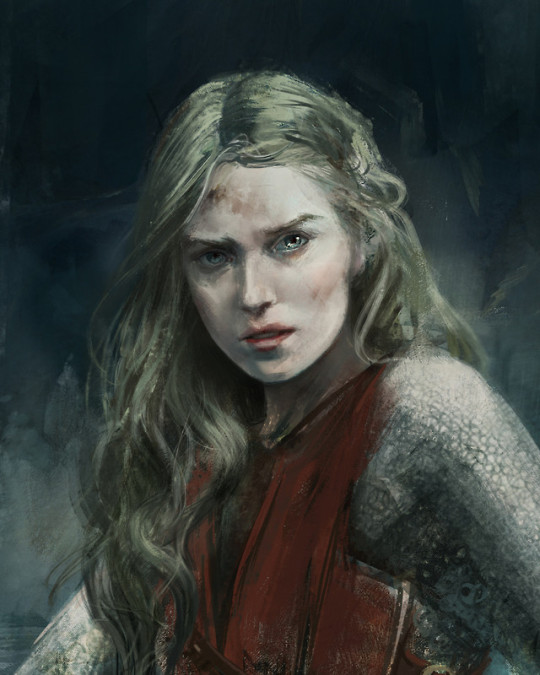
Éowyn
‘A sword rang as it was drawn. “Do what you will; but I will hinder it, if I may.”’
I painted this back in November 2017, on the kind request of Will o' Wisps for John Howe’s visit to AthensCon 2017. I had the good fortune to meet him there and give him a print of it. He had very kind words about it, leaving me on cloud nine, because Howe is one of my earliest art heroes.
The Lord of the Rings has very few women characters in it, something that has been the point of criticism almost from its publication in the 50s. It might be for this reason that Éowyn stood out for me, but also because I was moved by how much understanding Tolkien showed for her situation. When she wants to go to war, she is dissuaded by Aragorn, and is rightly bitter about it:
‘She answered: "All your words are but to say: you are a woman, and your part is in the house. But when the men have died in battle and honour, you have leave to be burned in the house, for the men will need it no more. But I am of the House of Eorl and not a serving-woman. I can ride and wield blade, and I do not fear either pain or death."
"What do you fear, lady?" he asked.
"A cage," she said. "To stay behind bars, until use and old age accept them, and all chance of doing great deeds is gone beyond recall or desire.”’
Tolkien gave Éowyn a voice, and not only that, but also a chance to prove her valour and to change the course of the history of Middle Earth as no one else but her could have. He wrote little of women, it’s true. The little he did write, though, was with deep humanity.
#Éowyn#eowyn#eilidh#eleni tsami#lotr#the lord of the rings#women in armor#women warriors#fantasy#Illustration#digital painting#tolkien
461 notes
·
View notes
Text

Galadriel by Jake Bartok
#Galadriel#Jake bartok#art#artwork#lord of the rings#lotr#rings of power#woman warrior#women warriors#trop#the rings of power#rop
91 notes
·
View notes
Text


Luis Royo
278 notes
·
View notes
Photo




𝒃𝒍𝒐𝒏𝒅𝒆 𝒘𝒐𝒎𝒆𝒏 𝒊𝒏 𝒂𝒓𝒎𝒐𝒖𝒓
#bbc morgause#bbc merlin#alice in wonderland 2010#tim burton's alice in wonderland#emilia fox#mia wasikowska#brienne of tarth#game of thrones#gwendoline christie#rings of power#rop galadriel#commander galadriel#morfydd clark#blonde women in armour#women warriors#women in armor#silver armour#fantasy aesthetic#medieval aesthetic#medieval fantasy#women in medieval fantasy#badass female characters#women with swords
899 notes
·
View notes
Text

I love historical figures who sound like anime protagonists
220 notes
·
View notes
Text

Ukrainian Hero
The Ukrainian combat medic Sergeant Daria Filipieva has been killed in battle against the Russian Army.
She was assigned the call sign "Lightning" because she could come to the aid of soldiers as quickly as a bullet or a fragment of a projectile.
Daria, a bright and creative individual, could not stand by and watch others defend their native land. She saved dozens of lives on the battlefield, like an angel. Her light will continue to shine from the sky forever.
Rest in Peace Daria, Ukraine will never forget your sacrifice!
#ukraine#russia#russian war on ukraine#Daria Filipieva#kia#killed in action#killed in battle#killed in war#war#world at war#women warriors#women in combat#combat#battle#fighting#peace#peace for all#peace for ukraine#rest in peace#rest in heaven#rest in paradise#sad
325 notes
·
View notes
Text

Gun Model/Former US Marine Bree Bunten
163 notes
·
View notes
Text
Am I aroace, yes
BUT
WOMEN IN ARMOR!
WOMEN IN ARMOR!!
#any ladies that want to share their armor please do#they got me kicking my feet and giggling#wlw post#wlw#aroace#ace#asexual#women#i love women#woman knight#women knights#women warriors#woman warrior#cosplayer#cosplay
29 notes
·
View notes
Photo
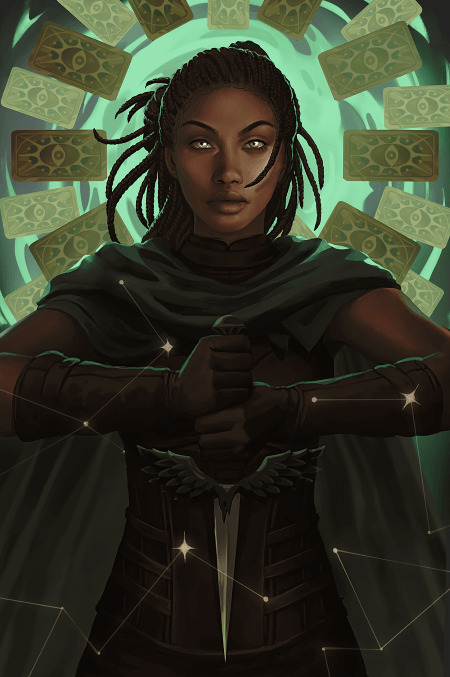
Ryber Fortiza, Sightwitch by Nipuni
775 notes
·
View notes
Text

Women warriors in Chinese history - Part 2
(Part 1)
"However, court confessions, unofficial histories, and local gazetteers do reveal a host of women warriors during the Qing dynasty when patriarchal structures were supposedly most influential. Women in marginal groups were apparently not as observant of mainstream societal gender rules. Daughters and wives of “peasant rebels,” that is, autonomous or bandit stockades, were frequently skilled warriors. Miss Cai 蔡†(Ts’ai) of the Nian (Nien) “army,” for example, “fought better than a man, and she was especially fine on horseback. She was always at the front line, fighting fearlessly despite the large number of government troops.” According to a folktale, she managed to rout an invading government force of several thousand with a hundred men and one cannonball after her husband led most of the Nian off to forage for food.
Related to the female bandits were the women pirates among whom Zheng I Sao 鄭一嫂†(literally, Wife of Zheng I; 1775–1844) is the best researched. “A former prostitute … Cheng [Zheng] I Sao could truly be called the real ‘Dragon Lady’ of the South China Sea.” Consolidating her authority swiftly after the death of her husband, “she was able to win so much support that the pirates openly acclaimed her as the one person capable of holding the confederation together. As its leader she demonstrated her ability to take command by issuing orders, planning military campaigns, and proving that there were profits to be made in piracy. When the time came to dismantle the confederation, it was her negotiating skills above all that allowed her followers to cross the bridge from outlawry to officialdom.”
We know slightly more about some of the women warriors involved in sectarian revolts. Folk stories passed down orally are one of the sources. Tales that proliferated in northern Sichuan on the battle exploits of cult rebels of the White Lotus Religion uprising in Sichuan, Hunan, and Shaanxi beginning in the late eighteenth century glorify several women warriors. The tall and beautiful Big Feet Lan (Lan Dazhu 籃大足) and the smart and skillful Big Feet Xie (Xie Dazhu 謝大足) vanquished a stockade together; the young and attractive Woman He 何氏 could kill within a hundred feet by throwing daggers from horseback. The absence of bound feet in Big Feet Lan and Big Feet Xie suggests their backgrounds were either very poor, unconventional, or non-Han.
Sectarian groups accepted female membership readily, and many of these women trained in the martial arts. Qiu Ersao 邱二嫂†(ca. 1822–53), leader of a Heaven and Earth Society (Tiandihui 天地會) uprising in Guangxi, joined the sect because of poverty and perfected herself in the martial arts. Some women came to the sects with skills. Su Sanniang 蘇三娘, rebel leader of another sect of the Heaven and Earth Society, was the daughter of a martial arts instructor. Such sectarian rebel bands are frequently regarded as bandit groups. A history of the Taiping Revolutionary Movement refers to these two cult leaders as female bandit chiefs before they joined the Taipings.
Male leaders of religious rebellions frequently married women from families skilled in acrobatic, martial, and magic arts. These women tended to be both beautiful and charismatic. Wang Lun 王倫, who rebelled in 1774 in Shandong, had an “adopted daughter in name, mistress in fact,” by the name of Wu Sanniang 烏三娘 who was one of Wang’s most powerful warriors. Originally an itinerant performer highly skilled in boxing, tightrope walking, and acrobatics, she terrified the enemy with spellbinding magic. She brought a dozen associates from her old life to the sect, and they all became fearsome warriors known as “female immortals” (xiannü 仙女); three of them, including Wu Sanniang, lived with Wang Lun as “adopted wives” (ifu 義婦). A tall, white-haired woman at least sixty years old, possibly the mother of one of these acrobat-turned women warriors, wielded one sword with ease and two almost as effortlessly. Dressed in yellow astride a horse, hair loose and flying, she was feared as much for her sorcery as for her military skills. Her presence indicates that some of the women came from female-dominated itinerant performing families. Woman Zhang 張氏and Woman Zhao 趙氏, wives of Lin Zhe 林哲, another leader of the cult, were also known for being able to brandish a pair of broadswords on horseback.
Hong Xuanjiao 洪宣嬌†(mid nineteenth century), also known as Queen Xiao (xiaohou 蕭后), wife of the West King of the Taiping Heavenly Kingdom (taiping tianguo 太平天國), was so stunningly beautiful and impressive in swordsmanship that she mesmerized the entire army during battles. The link between early immortality beliefs and shamanism also suggests that these women warrior “immortals” of sectarian cults may represent surviving relics of the female shamans who occupied high positions during high antiquity.
During the White Lotus Religion rebellion in Sichuan, Hunan, and Shaanxi beginning in 1796, five of the generals were at once leaders and wives of other leaders of the cult. They were Woman Qi née Wang (Qiwangshi 齊王氏; Wang Cong’er 王聰兒), Woman Zhang née Wang (Zhangwangshi 張王氏), Woman Xu née Li (Xulishi 徐李氏), Woman Fan née Zhang (Fanzhangshi 范張氏), and Woman Wang 王†née Li 李 (Wanglishi 王李氏). In the Heavenly Principle Religion (tianlijiao 天理教) rebellion that began in Beijing during 1713, the wife of its leader, Li Wencheng 李文成, led three invasions into the city. There was even a “Female Army” (niangzijun 娘子軍) within the Eight Trigrams (baguajiao 八卦教) uprising in Shandong during the Daoguang 道光† reign (1821–51). The female generals, Cheng Sijie 程四姐†and Yang Wujie 楊五姐, were particularly impressive when they wove among enemy forces in the style of “butterflies flitting among flowers,” wielding broadswords on horseback, their hairpins glittering in the light.
A number of female rebel leaders used religion and magic to buttress their power. Many claimed to be celestials and were leaders of sectarian cults (...). Chen Shuozhen 陳碩貞†(?–653) mobilized a peasants’ uprising by declaring that she had ascended to heaven and become an immortal. Tang Sai’er (ca.1403–20), a head of the White Lotus Religion (bailianjiao 白蓮教), designated herself as a “Buddhist Mother” (fuomu 佛母). The spellbinding old woman warrior in Wang Lun’s Clear Water Religion (qingshuijiao 清水教) sect was known to the rebel community as a reincarnation of the highest White Lotus deity, the Eternal Venerable Mother (wusheng laomu 無生老母). Wang Lun relied on her for performing magic and the rituals for calling on their supreme deity. Woman Wang née Liu (wangliushi 王劉氏), one of the numerous female leaders of the White Lotus Religion revolt, also titled herself the Eternal Venerable Mother. Wang Cong’er (1777–98), originally an itinerant entertainer, became the commander in chief of the rebel army she launched with her husband, a master in the White Lotus Religion.
Indeed, itinerant performers such as Wu Sanniang mentioned above were frequently trained in the martial arts since childhood and must have been skilled at performing magic tricks as well. Lin Hei’er 林黑兒†(?–1900), leader of Red Lanterns (hongdengzhao 紅燈照), the young women’s branch of the Boxer’s Movement (yihetuan 義和團), was also originally an itinerant entertainer (her husband was a boatman). Designating herself the Holy Mother of the Yellow Lotus (huanglian shengmu 黃蓮聖母), she taught her followers the skills of wielding swords and waving fans as well as magic to defeat their enemies. Wang Nangxian 王囊仙†(literally, Goddess Nang, 1778–97), an ethnic minority of the Miao tribe, was worshipped as a goddess by her tribesmen before she led them in revolt against the Chinese government."
Chinese shadow theatre: history, popular religion, and women warriors, Fan Pen Li Chen
#history#women in history#women warriors#warriors#warrior women#china#chinese history#asian history#historyblr#qing dynasty#19 century#18th century#Wang Cong’er#hong xuanjiao#su sanniang#qiu ersao#tang sai'er#asia#Zheng Yi Sao
190 notes
·
View notes
Text
Maharani Durgavati
Durgavati was the daughter of King of Bundelkhand, married to Raja dalpad of Gondwana, in Madhaya Pradesh.
Soon, tragically Raja died and Queen Durgavati with her 5 year old toddler stepped up to the throne. She managed the whole kingdom exceptionally well, as recorded by Akbar’s historian. The kingdom did not suffer any major setback even after their king died.

Gondwana was a rich kingdom, with a beautiful queen which became the target of the Mughals. They didn't wanted to simply take the kingdom under their control, the commander Asaf Khan also “wanted to touch the beauty of Gondwana”.
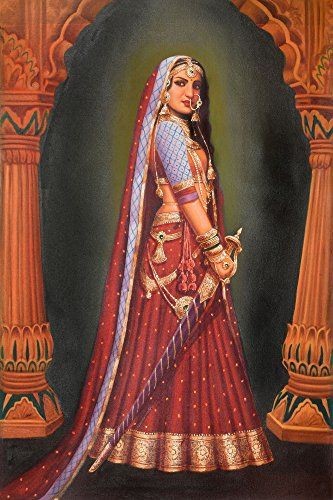
In 1564, Asaf Khan marched with 10,000 cavalries towards Gondwana, Rani Durgavati marched with 5,000 men to the battlefield.
She led the army well and killed about 500 enemies, she came out victorious by the end of the day, later she purposed to “surprise attack” the enemies or “Gorilla Attack” but none of the council members agreed to that.
By the next morning, Asaf Khan’s army was in a much better place and the fighting continued for 3 exhausting days. By that time only 200 of her men were left but the thought of giving up never once crossed her mind. Her bravery and courage never wavered.
During the battle, one arrow pierced her temple and another pierced her neck, causing her to lose consciousness. When she opened her eyes, the inevitable defeat was clear.

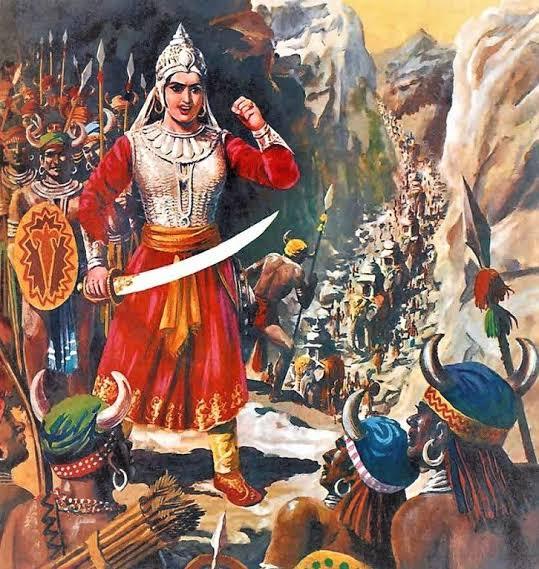
Instead of falling in the hands of men that had nothing but lust for her and would eventually throw her in Harem with other women, that previously were queens of conquered kingdoms that Mughals kept as sex slaves, she took our her dagger and killed herself to save her honor and prevent invaders from doing heinous things to her body, her martyrdom day (24 June 1564) is commemorated as “Balidan Diwas”.
The Mughal army then marched to the fort to loot it's treasure. They found staggering amount of gold pots full of gold, jewels, expensive stones etc.
When they opened a room, it was full of burnt bodies of women that commited Jauhar upon hearing the news of Rani’s defeat. These women committed Jauhar to save their honor and to prevent the Mughals from taking them as sex slaves, unfortunately 2 women were still alive, stuck behind a large wooden block that saved their lives. These two women were then taken to Akbar's court and predictably put into Harem.
#rani durgavati#india#mughal empire#gondwana#indian queen#indian history#madhaya pradesh#forgotten bharat#female warriors#women warriors#queens of india#hinduism#pseudo secularism#hindu kingdom#mughal invasion
43 notes
·
View notes
Text

She-Ra by Ivan Jacob
#Ivan Jacob#she-ra#shera#art#artwork#adora#she ra and the princesses of power#she-ra and the princesses of power#satpop#woman warrior#women warriors#spop#female characters#fantasy
22 notes
·
View notes
Text

Lieutenant Deitra & Lieutenant Lena (My OC) by @jun-c
#battlestar galactica#bsg#battlestar#women viper pilots#female colonial warriors#female viper pilots#women warriors#battlestar galactica 1978#lost planet of the gods#lt deitra#deitra#lieutenant deitra#lt. lena#lieutenant lena#lena#battlestar galactica original art#shelia wills#leann hunley
13 notes
·
View notes

